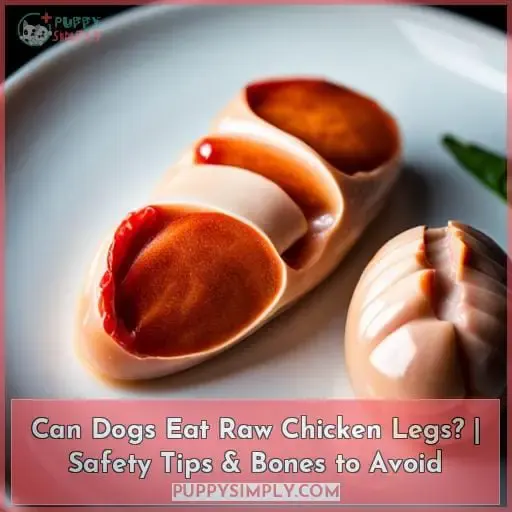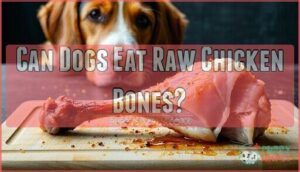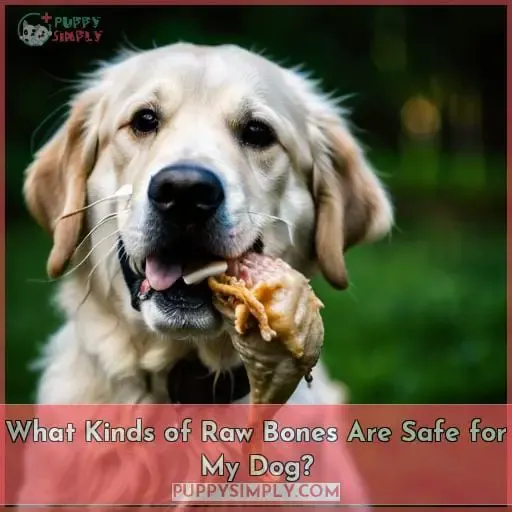This site is supported by our readers. We may earn a commission, at no cost to you, if you purchase through links.
 Are you curious if dogs can eat raw chicken legs? When it comes to feeding your pup a balanced, nutritious diet, the answer is not so simple. Raw diets for dogs have become popular in recent years due to their potential health benefits—however, there are also risks associated with feeding your dog uncooked meats like chicken.
Are you curious if dogs can eat raw chicken legs? When it comes to feeding your pup a balanced, nutritious diet, the answer is not so simple. Raw diets for dogs have become popular in recent years due to their potential health benefits—however, there are also risks associated with feeding your dog uncooked meats like chicken.
In this article, we’ll explore some of the pros and cons of giving your pup raw poultry as well as provide safety tips and bones that should be avoided when going down the route of a raw diet for dogs.
Table Of Contents
- Key Takeaways
- Can Dogs Eat Raw Chicken Legs?
- Is Raw Chicken Safe for Dogs?
- Is Raw Chicken Good for Dogs?
- Can Dogs Eat Raw Chicken Bones?
- Can Dogs Eat Raw Chicken Eggs?
- The Problem With Raw Chicken
- How Do I Make Sure My Dog’s Food is Safe?
- What Kinds of Raw Bones Are Safe for My Dog?
- Raw Chicken, Duck and Turkey Bones Are Edible for Dogs
- Are Raw Pork and Beef Bones Safe for Dogs?
- Always Supervise Your Dog When You Give Him Raw Bones
- Know Your Dog’s Chewing Style
- Separate Multiple Dogs When You Give Them Bones
- Feed Your Dog His Raw Meals on a Towel or Outside
- Introduce the Raw Bones and Raw Meat Slowly
- Frequently Asked Questions (FAQs)
- Conclusion
Key Takeaways
- Raw chicken legs provide a satisfying chewing experience for dogs.
- Raw chicken legs can pose risks such as bacterial contamination and choking hazards from bones.
- It is important to consult with a veterinarian before introducing raw chicken legs into a dog’s diet and to monitor for any adverse reactions.
- Raw chicken legs should be introduced slowly, under supervision, and other meats and organ meats should be included in the diet for nutritional balance.
Can Dogs Eat Raw Chicken Legs?

You and your pup may be tempted to try raw chicken legs, but it’s important to weigh the risks against the benefits. The bones can pose a choking hazard, as well as microbial risks like Salmonella or E.
coli that are eliminated when cooked. Even if you choose not to cook them, there is still potential for nutrition issues if they make up too much of their diet. A balanced diet with other meats and organ meat is key in providing complete nutrition for your dog.
Raw chicken legs can provide dental benefits, such as satisfying chewing urges. However, always supervise carefully when feeding raw bones due to safety concerns. Small bone fragments can break off, which could lead to choking hazards or internal injuries depending on the size and breed of the dog being fed these snacks.
If you do decide to try out natural chews like this, ensure you get expert guidance from vets regarding the ratios needed to maintain proper nutrient balance within their meals.
Is Raw Chicken Safe for Dogs?
It’s important to consider the risks and benefits of feeding your pup raw chicken legs, as consumption may not always be safe. To ensure a balanced diet for your dog, it’s essential to understand their dietary needs and how they could potentially benefit from raw feeding.
Raw chicken legs are great for exercising jaw muscles while providing dental health benefits due to chewing on the bones. However, there are numerous potential health risks associated with consuming raw meat, such as harmful bacteria found in both uncooked meats like chicken or eggs, as well as other foods that have not been cooked properly using safe cooking methods.
If you decide that you would like your pet to consume some form of raw food, including meaty bones, then it is advisable to consult a vet before making any changes. They can assess whether this would be an appropriate choice based on size and breed type.
Additionally, if your dog has consumed any form of uncooked poultry, monitoring them closely afterwards can help identify signs of adverse reactions such as vomiting, diarrhea, or lethargy. These signs should be addressed immediately by contacting professional medical advice.
Numeric List:
- Understand canine dietary needs
- Consider potential benefits & drawbacks when deciding about introducing new foods into the diet
- Monitor dogs after eating – look out for signs of excessive discomfort
Is Raw Chicken Good for Dogs?
Feeding your pup raw chicken legs can be beneficial, but consider the risks before deciding if it’s right for them. A balanced raw diet of chicken and other meats with organ meat and bone helps provide necessary protein, fat, vitamins, and minerals.
The chewing urge is satisfied by crunchy bones, while dental benefits are provided by feet or wings. Livers offer further nourishment. However, experts advise against feeding pets uncooked poultry due to potential bacteria such as Salmonella or Listeria.
Cooked food is safer than raw. Vet guidance should always be sought when considering a homemade dog food. Monitor your pet closely after eating any new treats or foods for vomiting, diarrhea, or lethargy signs.
Consider providing Mighty Paw Bully Sticks instead of something like rawhide, which may contain small fragments that could cause choking hazards.
Raw eggs can also form part of a healthy diet, offering essential fatty acids plus biotin, which improves skin health in addition to more obvious nutrients found in egg whites and yolk proteins.
Can Dogs Eat Raw Chicken Bones?
Though raw chicken bones are less risky than cooked ones, they still have the potential to pose a choking hazard.
There are several factors to consider when thinking about feeding your dog raw chicken bones: bone safety, choking risk, vet guidance, and complete nutrition.
Raw diets can provide delicious recipes for dogs if done properly and slowly introduced. However, it’s essential to recognize that bacteria such as Salmonella or E. coli can be present in raw poultry meat.
Cooking kills these bacteria, which is why some vets may advise against feeding uncooked poultry products.
If you decide to feed your dog with a diet containing uncooked items like chicken legs, then make sure not only that they meet the nutritional requirements of their individual needs but also look out for any signs of illness such as vomiting or diarrhea after consumption.
Can Dogs Eat Raw Chicken Eggs?
You may be wondering whether your pup can consume raw chicken eggs, and the answer is that it depends on several factors. Raw egg whites contain an enzyme called avidin which can interfere with the absorption of biotin, a B-vitamin essential for skin health.
The yolk contains valuable nutrients like fatty acids but also carries potential bacteria risks including Salmonella and E. coli due to poor sanitation practices in poultry farming facilities. As such, vets often advise against feeding dogs any kind of raw meat or eggs as part of their diet.
Cooked versions are safer alternatives because they eliminate many bacteria risks associated with consuming them uncooked.
| Meat | Safety | Nutrition Value |
|---|---|---|
| Beef | Cooked Safely | High Protein Content & Essential Amino Acids |
| Turkey | Cooking Kills Bacteria Risks | Omega 3 Fats |
| Pork | Should Be Well-Cooked | Vitamins A & D |
| Duck | Also Needs To Be Fully Cooked | Have Vitamin K |
While there’s no one definitive answer when it comes to eating raw chicken eggs safely, experts generally recommend providing only cooked versions in moderation as part of a balanced diet supplemented by other meats such as beef, turkey, pork, and duck.
The Problem With Raw Chicken
It’s important to understand the risks associated with giving your pup raw chicken legs, from potential bacteria to choking hazards. Raw chicken can contain dangerous parasites and bacteria like Salmonella, E. coli, and Listeria that cooking kills off.
While raw bones are good for exercising a dog’s jaw muscles as well as satisfying their urge to chew, they can pose a choking hazard if not monitored carefully when being fed or swallowed whole by smaller dogs.
A balanced diet is essential for any pet. Feeding solely on raw meat may provide dental benefits such as cleaning teeth due to its texture, but it doesn’t necessarily supply all the nutrients needed for them to grow healthy and strong.
Feeding on necks alone isn’t recommended either since there is an imbalance of calcium-phosphorus ratio which could cause health problems down the road.
Taking into account these factors helps ensure your pet has nutritional needs met without having serious risks involved with consuming raw foods. Consult your vet before deciding if this type of diet fits your pup’s lifestyle safely.
How Do I Make Sure My Dog’s Food is Safe?
Safety is key when feeding your pup raw chicken legs, so make sure you get expert advice and weigh the risks versus benefits first. There are safer alternatives to rawhide, like bully sticks, that provide dental benefits as well.
It’s also important to consult a vet before switching your pet’s diet or making homemade meals for them. Ensure the food aggression of multiple dogs is kept in check by separating them while they eat and supervise their chewing habits carefully.
A balanced raw chicken diet should include other meats, organs, and bones with proper ratios for nutrition balance. Commercially produced pet foods can help ensure this if you’re unsure what proportions are needed yourself.
Finally, keep an eye out for any signs of illness after feeding, such as vomiting or diarrhea.
What Kinds of Raw Bones Are Safe for My Dog?
You may have heard that raw chicken, duck, and turkey bones are edible for dogs. But what about other types of raw bones? Are pork and beef bones safe for your canine companion? It’s important to understand how to safely feed your dog his meals with these kinds of ingredients.
Always supervise him when he is chewing on them, separate multiple dogs if they are eating together, feed on a towel or outside the house if possible, and introduce new items slowly.
Raw Chicken, Duck and Turkey Bones Are Edible for Dogs
Make sure your pup enjoys the health benefits of raw bones, such as chicken, duck, and turkey legs! Seek vet advice for balanced nutrition as raw diets can have risks. Chew toys can help reduce safety concerns related to bacteria. Dogs need proper ratios of other meats and organ meat to stay healthy.
Incorporate chew toys into their diet for dental hygiene while ensuring a balanced meal without exposing them to danger from uncooked ingredients.
Are Raw Pork and Beef Bones Safe for Dogs?
Be mindful of the risks involved when considering raw pork or beef bones for your pup. Bones vary in size, density, texture, and safety – impacting nutrition absorption.
Consider bone size and thickness when selecting appropriate bones.
Check bone density as this affects how easily a dog can chew it.
Observe bone texture to determine if there are any potential sharp edges that could cause injury or splintering.
Assess overall safety by looking at the type of meat used and supervising while chewing.
Always Supervise Your Dog When You Give Him Raw Bones
Supervise your pup closely when giving him raw bones to ensure they don’t become a choking hazard; on average, over 1 million pets are treated for choke-related incidents each year! Weigh the risks and rewards of natural beef bones for dental health while considering food aggression.
Know Your Dog’s Chewing Style
Know how your pup chews, so you can choose the right raw bone for him; from bully sticks to chicken legs. Consider his size and chewing style when selecting bones to ensure dental health and reduce the risk of food aggression or choking.
Separate Multiple Dogs When You Give Them Bones
When you have multiple dogs, separate them when giving bones to avoid aggression. A survey by the American Veterinary Medical Association found that over 50% of dog owners experienced food aggression in their pets.
Chewing on raw bones can be beneficial for exercise and dental health, but safety must come first. Consider your pets’ individual sizes and chewing styles. Raw meat ratios also need to follow vet guidance for a balanced diet.
This is key in avoiding potential risks associated with raw chicken legs or other products.
With proper precautions taken into account, you’ll ensure an enjoyable experience while keeping everyone safe!
Feed Your Dog His Raw Meals on a Towel or Outside
Feed your pup its raw meals on a towel or outside to avoid messes. Dog-proof your space, choose bone sizes for their chewing habits, and provide firm stools with balanced raw feeding.
Introduce the Raw Bones and Raw Meat Slowly
Start by introducing the raw bones and meat slowly to your pup. Only offer one type of protein, such as chicken or beef, per meal initially. Studies show that nearly 70% of dogs prefer cooked chicken! Ensure bone safety with vet advice on nutrition balance for a healthy switch.
Frequently Asked Questions (FAQs)
What are the risks of feeding my dog raw chicken legs?
Feeding your dog raw chicken legs carries risks of choking, bacterial contamination, and nutritional imbalance. Monitor for signs of illness such as vomiting or lethargy, and consult a vet about the best diet plan for your pup.
How often should I feed my dog raw chicken legs?
Frequency of feeding raw chicken legs to your pup depends on its size and chewing style. Consider the risks before serving them often; even with supervision, small bone fragments may break off.
Does raw chicken provide complete nutrition for my dog?
No, raw chicken alone does not provide complete nutrition for your pup. It needs to be balanced with other meats, organ meat, and bone in proper ratios.
Do I need to cook the raw chicken legs before feeding them to my dog?
For safety, it is recommended to cook raw chicken legs before feeding them to your dog. Raw meat may contain bacteria that could make your pup sick, so cooking the legs will ensure any potential contaminants are destroyed.
Are there any alternatives to feeding my dog raw chicken legs?
Consider alternatives such as Mighty Paw Bully Sticks, a natural beef pizzle that satisfies your dog’s urge to chew. This safer option provides dental benefits and comes in various lengths and thicknesses.
Supervise pets when chewing to prevent choking as there is a chance of small bone fragments breaking off.
Conclusion
So, can dogs eat raw chicken legs? The answer is, not without significant risk. Raw chicken can be dangerous for dogs due to bacteria such as Salmonella, E. coli, and Listeria, and it can cause choking due to the bones. There is also the risk of inadequate nutrition, as a raw chicken-only diet does not provide complete nutrition.
Even if you decide to give your dog raw chicken, it’s important to supervise them, provide other meats and organ meat, and introduce raw chicken slowly.
It’s always best to consult your vet first before switching to a raw or homemade diet. With proper care and the right knowledge, your dog can enjoy raw chicken safely.













